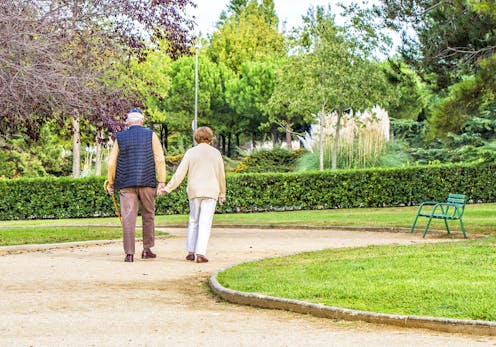Eight simple changes to our neighbourhoods can help us age well
- Written by Jerome N Rachele, Research Fellow in Social Epidemiology, Institute for Health and Ageing, Australian Catholic University

This article is the first in a series, Healthy Liveable Cities, in the lead-up to the Designing Healthy Liveable Cities Conference in Melbourne on October 19 and 20.
Where we live can play a big part in ageing well, largely because of the links between physical activity and wellbeing. Research shows that two-thirds of Australians prefer to age in place. That is, we want to live independently in our homes for as long as we can. Our neighbourhoods and their design can then improve or hinder our ability to get out of the house and be physically active.
The rapid ageing of Australia’s population only adds to the importance of neighbourhood design. In 2016, 15% of Australians were aged 65 or older. That proportion is projected to double by 2056.
These trends present several social and economic challenges, particularly for the health sector. Designing neighbourhoods in ways that promote physical activity can help overcome these challenges.
Further reading: Contested spaces: we need to see public space through older eyes too
Eight simple steps
The following is a short list of evidence-based steps local and state governments can take to assist older people to be physically active. These involve minor but effective changes to neighbourhood design.
Improve footpaths: Research indicates that older people have a higher risk of falls. Ensuring footpaths are level and crack-free, and free from obstructions, will encourage walking among older people – especially those with a disability.
Connected pedestrian networks: Introducing footpaths at the end of no-through-roads and across long street blocks reduces walking distances to destinations. This makes walking a more viable option.
Slowing traffic in high-pedestrian areas: Slowing traffic improves safety by reducing the risk of a collision. It also reduces the risk of death and serious injury in the event of a collision.
Age-friendly street crossings: Installing longer pedestrian crossing light sequences gives older pedestrians more time to cross, and installing refuge islands means those who walk more slowly can cross the street in two stages.
Disabled access at public transport: Although a form of motorised transport, public transport users undertake more incidental physical activity compared with car users. This is because they walk between transit stops and their origins and destinations. Improving disabled access helps make public transport a viable option for more older people.
Places to rest: Providing rest spots such as benches enables older people to break up their walk and rest when needed.
Planting trees: Planting trees creates more pleasant scenery to enjoy on a walk. It also provides shade on hot days.
Improving safety: Ensuring that streets are well-lit and reducing graffiti and signs of decay are likely to improve perceptions of safety among older people.
Further reading: Contested spaces: a user’s guide to shared paths
Why physical activity matters
Physical function – the ability to undertake everyday activities such as walking, bathing and climbing stairs – often declines as people age. The reason for this is that ageing is often accompanied by a reduction in muscle strength, flexibility and cardiorespiratory reserves.
Regular physical activity can prevent or slow the decline in physical function, even among those with existing health conditions.
Middle-to-older aged adults can reduce their risk of physical function decline by 30% with regular physical activity (at least 150 minutes per week). This includes recreational physical activity, like walking the dog, or incidental physical activity, such as walking to the shops or to visit friends.
By making minor changes as outlined above, the health and longevity of our elderly population can be extended. Such changes will help our elderly age well in place.
The Designing Healthy Liveable Cities Conference is being hosted by the NHMRC Centre of Research Excellence in Healthy Liveable Communities in Melbourne on October 19-20. You can register here.
Authors: Jerome N Rachele, Research Fellow in Social Epidemiology, Institute for Health and Ageing, Australian Catholic University
Read more http://theconversation.com/eight-simple-changes-to-our-neighbourhoods-can-help-us-age-well-83962





